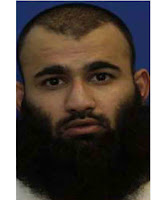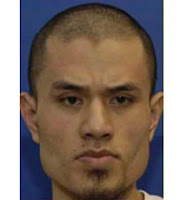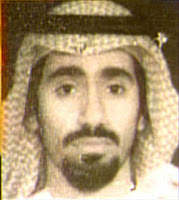Inmates regarded by the authorities as 'high-value detainees' alleged to have taken part in 9/11 and other terrorist plots (they include two Malaysians)
Hambali (Ridouan Isomuddin)
Indonesian. In Guantánamo since September 2006
Accused of being behind the October 2002 Bali bombings that killed more than 200 people, after being recruited to jihadism at a mosque in Malaysia. Planned strikes against UK and US embassies in Cambodia. Captured in Thailand in 2003. Allegedly involved in al-Qaida’s “biological weapons programme”
Abu Faraj al-Libi
Libyan. In Guantánamo since September 2006
Promoted to be operational chief of al-Qaida in both Afghanistan and Iraq, after capture of 'KSM' (Khalid Sheikh Mohammed). Captured by Pakistan in 2005. Planned to assassinate President Musharraf of Pakistan. “Has knowledge of al-Qaida possibly possessing a nuclear bomb.”
Ramzi bin al-Shibh
Yemeni. In Guantánamo since September 2006
The alleged co-ordinator of the entire 9/11 plot from a base in Germany, who was picked up by Pakistan in a raid on a house in Karachi in 2002. Claimed to have also planned with Khalid Sheikh Mohammed in June 2002 to crash a hijacked plane into Heathrow airport, London
Majid Khan
Pakistani. In Guantánamo since September 2006
Allegedly tasked by 'KSM' to poison water reservoirs and blow up multiple fuel stations on the US mainland 'as well as a project targeting nuclear reactors'. He was termed a 'willing suicide operative' who delivered funds for a 2003 Marriott hotel bombing in Jakarta and had probably been arrested in Pakistan through his links with 'KSM'
Mohd Farik Bin Amin
Malaysian, detained in Guantánamo since September 2006
Arrested leaving a bookstore in Thailand in 2003, he is called a senior al-Qaida operative who swore an oath of allegiance to Osama bin Laden. Targeted the UK embassy in Cambodia and helped with an abortive 'west coast airliners plot' in the US to crash a plane into 'the tallest building in California'. Captured computer allegedly contained images of the Space Needle in Seattle and bomb diagrams. Trained in camps in Afganistan. Allegedly tried to buy a surface-to-air missile
Bashir Bin Lap
Malaysian, detained in Guantánamo since September 2006
Al-Qaida member who tried to learn to fly, cased Israeli flights out of Bangkok airport and was due to lead a three-man suicide team in KSM’s disrupted 'west coast airliners' hijacking plot. Former member of Malaysian military, trained with al-Qaida in Afghanistan, cased the UK embassy in Kuala Lumpur and was captured in Thailand in 2003. 'He thought it would be a good idea to attack world sporting events, such as soccer matches, because many westerners are generally in attendance ... He would not be worried about accidentally killing Muslims during such an attack, because any Muslims attending such a sinful event were not pious Muslims'
Khalid Sheikh Mohammed
Pakistani, detained in Guantánamo since September 2006.
The alleged mastermind behind the attacks of 11 September 2001, he is said by US forces to have 'described himself as the head of al-Qaida’s military committee'. His file alleges he planned the destruction of the Brooklyn Bridge, the collapse of a Chicago apartment block and destruction of a US hotel or fuel station as follow-ups to the September 2001 attacks. Repeatedly waterboarded in CIA detention prior to his transfer. He is one of 16 'high-value' detainees transferred to Guantánamo to stand trial
Abd al-Rahim Hussein Muhammad Abdah al-Nashiri
Yemeni, detained in Guantánamo since September 2006
Believed by US forces to be 'one of the highest-ranking, most skilled and dangerous al-Qaida operatives captured to date', al-Nashiri is allegedly a key Bin Laden aide. His file details an alleged plot to attack a UK base on the Gibraltar – with the target chosen after being featured on a 'news documentary'. His notes stress excellent contacts with 'Yemeni tribes and Yemeni security services' which were used to provide documents and cover for extremists
Haji Hamidullah
Afghani detained in Guantánamo since November 2003
Hamidullah’s file calls him not only a senior leader of anti-coalition militias in Afghanistan, but also an Iranian intelligence agent. Hamidullah is described as having been imprisoned by the Taliban before securing his escape and fleeing to Iran – working as a baker for four months – then returning as an Iranian agent and channeling Iranian money to anti-coalition groups. His intelligence assessment concludes: 'Detainee probably has information on Russian and Iranian support to HIG and the Taliban efforts against the Karzai Afghan government'
Maad al-Qahtani
Saudi Arabian, detained in Guantánamo since February 2002
The alleged intended '20th hijacker' can never stand trial after the Bush administration admitted torture in 2008. He remains in Guantánamo where officials recommend he is held indefinitely. Qahtani’s file describes his attempted entry into the US from the UK in 2001, before the attacks. Qahtani successfully entered the UK but failed to gain entry to the US as officials noted he had purchased no return ticket. His file notes US forces believe Qahtani 'likely has information on al-Qaida’s activities regarding the 11 September 2001 attacks which has not been divulged, such as other operatives who were unable, but intended, to participate'
Facts - Did you know?
Only the most dedicated, well-trained recruits are allowed to become full al Qaeda members. Osama bin Laden hand-picked the operatives used to hijack U.S. planes in the 9/11 attack.
In 2002 and 2003 no successful attacks occurred on U.S. soil but attacks against U.S. interests worldwide continued. In 2002 of all anti-U.S. attacks carried out by various terrorist organizations, the most—forty-six—occurred in Latin America followed by sixteen in the Middle East and ten in Asia. The type of facilities targeted most were U.S. businesses. Most terrorist threats and attacks involved bombings.
Each year the U.S. State Department compiles a list of Foreign Terrorist Organizations known as FTOs. Compiled since 1997, the list took on a new sense of urgency since 9/11. In 2004 the list included thirty-six terrorist organizations. The U.S. government may freeze any FTO assets in U.S. financial institutions, may deny entry of a FTO member into the United States, and may prosecute any U.S. citizen or person in the United States who supports an FTO in any way.











